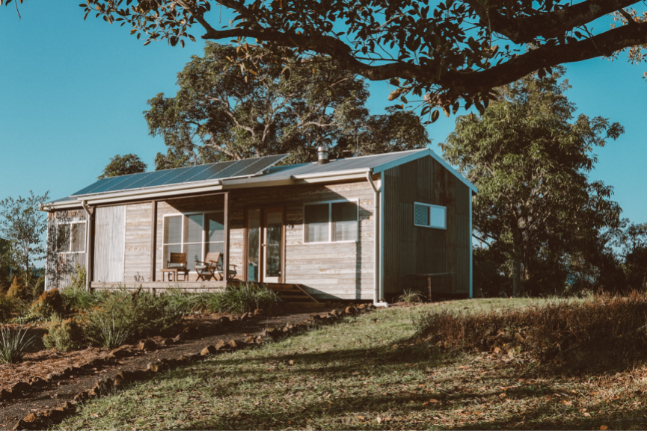How to insulate your home, the sustainable way
Climate change and rising energy prices are making insulation a key component for sustainable living goals. Here’s how to do it right, according to the experts.
During the 2019–20 Australian bushfires many of us discovered the ease with which smoke can infiltrate our private living spaces. Given that we spend about 90 per cent of our lives indoors, how can we safeguard our home air from external pollution and be more thermally comfortable without massive expense?
Leaky houses
We’ve all heard of leaky guts. Houses can be leaky too, lacking insulation, and full of gaps, cracks and holes, says Michael Ambrose, a senior experimental scientist with the CSIRO and qualified architect.
“They can lead to enormous amounts of heat loss, particularly if you’re running a heating system, because your house is at positive pressure. If there’s any gaps, out it all goes.”
Prior to 2000 there were no regulatory requirements to install insulation in homes, he reveals. The worst leaky homes tend to be old timber houses on suspended floors. “People that are in old homes would know all about this when it’s a windy day and you can feel the breeze going through,” Ambrose says.
Plant deciduous trees and vines near windows and doors: these lose their leaves in winter letting sun enter, but create shade in summer.
The CSIRO recently measured the leakiness of 125 new Australian homes, using what’s known as a “blower door test”. Essentially, a big fan unit put into the front door of the house blows air in, then is reversed sucking air back out. This measures how much air is escaping from the house. The team found the homes had an average of 15 air changes per hour under pressure. “That translates to around about one complete air change per hour under normal pressure, so the entire volume of air in your homes being replaced,” Ambrose says. “We are three times higher than what is allowed in most other parts of the world, including the US and Europe. Imagine if you are trying to heat all the air in your home. Every hour, all that air-conditioning will be lost. And that’s the new homes. Our old homes are sometimes double that rate.”
Australia’s leaky home syndrome
Our relatively temperate climate combined with once cheap and plentiful energy means there’s never really been a huge imperative for us to prioritise insulation, Ambrose explains. “We don’t get extreme winters. Natural gas was seen as a waste product. And so, using lots of gas to heat your home didn’t have a big cost implication. It’s only now with energy prices increasing, people are thinking, ‘Oh, my God, it’s costing me a fortune to maintain.’” Until recently, air-conditioning systems were expensive. “Now that they’ve become so cheap, people put these systems in, but they’re putting them into homes that are pretty leaky,” Ambrose says. “You’re running air-conditioning in a home never designed for air-con.”
Because energy efficiency requirements tend to be done at the end of a design process, Ambrose says homeowners can lose the opportunity to improve the thermal comfort of a home during the early design phase with measures like double-glazed windows and passive solar design. And the fact the payback periods of the cost of insulation are measured in decades can make it tricky to justify retrofitting, he adds.
Why insulate?
Insulation provides a resistive barrier that reduces heat flow from one space to another, Ambrose explains. In winter, it restricts the flow of heat from your interior to the outside environment. In summer it works in reverse, restricting hot outside temperatures infiltrating indoors.
The main benefit of insulation is to reduce heating and cooling and the knock-on cost — about 40 per cent of the energy bill of a home (20 per cent for new homes), Ambrose says.
A really well-insulated home built around passive design principles often doesn’t require any additional heating or cooling. “There’s plenty of examples in Australia where they’ve achieved this, including Tasmania,” he says. Along with excellent insulation, such high-energy-efficient rated homes utilise the sun, thermal mass and other design features.
Insulation also provides acoustic protection – useful if you live among stress-inducing noise like traffic or aircraft — and translates into carbon emission savings. Given long-term climate projections towards extreme weather, insulation is an increasingly important strategy within any sustainable living and health goals.
Health issues
A poorly insulated home combined with climate extremes and energy poverty (inability to afford to heat and cool one’s home) can impact our health and wellbeing. Excess heat and cold adversely affect our circulatory system and lungs.
According to the 2018 WHO Housing and Health Guidelines, cold indoor temperatures (below 18°C) are linked with greater risk of respiratory conditions like asthma, worsening of chronic obstructive pulmonary disease (COPD), increased blood pressure and cardiovascular events. While Australia’s considered a warm country, ironically, more deaths are associated here with cold indoor weather than indoor heat. WHO recommends maintaining indoor temperatures between 18°C and 24°C for optimum health.
A leaky home also provides less protection from outdoor toxins like particles from bushfire smoke. Those with lung, cardiovascular and other preexisting health problems are most at risk.
Temperature additionally affects our mood. Cold indoor air is linked to depression for some, extreme heat to greater aggression and irritability.
How to insulate
If you’re building, consider insulation and passive solar elements early in the design process. While expensive, it’s also possible to retrofit insulation into an existing home or introduce portable measures into somewhere you’re renting.
Consider the weather in your area. Do you need to insulate more against heat or cold? Or both? A great resource is the Australian government’s sustainable housing YourHome site. It reveals that most summer heat gain occurs through ceilings and windows (about 25 to 35 per cent each), followed by walls, then floors. Air leakage from draughts can account for 5 to 25 per cent of heat gain.
Most winter heat loss occurs via the ceiling (25 to 35 per cent), followed by air leakage from draughts and walls, then windows and floors. Obviously, this varies depending on the design of your home.
Insulation batts significantly reduce thermal losses through ceilings, floors and walls and come with an R-value that rates how much resistance the material has, Ambrose says. “The higher the R-value number on a product the more resistance it has, although they cost more.”
Help clear contaminated or stuffy air by opening the home up when the outdoor air quality is at its best.
Ambrose suggests R2 in walls and R5 or R6 in ceilings in most parts of Australia. “There is a sweet point with all this,” he says. Higher-rated batts can also create a weight issue in ceilings requiring structural upgrading, he says. Otherwise, “insulating the ceiling space is relatively straightforward,” Ambrose says. Outside the build stage, however, it’s difficult accessing the cavity of walls. “It’s doable but expensive,” he says. Subfloor spaces can also be hard to get into. If the house is raised enough to enable access, an expanding foam is commonly used which sticks to the underside of the floorboards and covers the whole subfloor space. Rigid foam boards, stapled, studded or strapped in between the bearers of the floor joists, are another option.
Know your insulation materials
A 2018 report, A Guide to Healthier Upgrade Materials, by green-oriented building organisations in the US, notes that unhealthy chemicals in insulation materials can migrate from behind walls and floors into the home. Unfortunately, it’s a controversial and touchy topic within the building industry, poorly studied and regulated and hard to get to the bottom of. Common chemicals of concern in insulation and air-sealing products, according to the report, include halogenated flame retardants, formaldehyde-based binders, isocyanates and phthalate plasticisers.
From the health perspective of minimising chemicals, the researchers recommend using cellulose and fibreglass insulation and avoiding spray foam. Pre-foamed materials were rated a better option. Expanded cork board was deemed the most low-tox of the materials studied, but is expensive. While fibreglass particles can lodge in the respiratory system, eyes and skin, causing irritation and potentially much more serious problems, the majority view is that the risk is mainly to the installer.
The My Chemical Free House website also recommends insulation materials made from natural wool, recycled cotton, hemp and paper.
Creative insulation ideas
Focus on the biggest problem zones and those you spend most time in.
If floor draughts are causing issues, Ambrose (a former project leader for the Australian Zero Emission House project and the Low Income Energy Efficiency Project) suggests covering floors with carpet and rugs. If you’re renting, try carpet offcuts.
If you can afford it, or are replacing an old window, install double-glazed ones. The cost of these has come down considerably, he says. A less expensive effective solution is good old-fashioned heavy drapes. “The curtains act as a barrier and stop the air movement,” he explains. “A lot of heat transfers through glass.” Heavy curtains can reduce heat gain from windows by up to 33 per cent, according to the government Energy.gov.au site. Ideally, they should be floor-length with a pelmet at the top, weighted and light-coloured. Add an inner blind or curtain for extra insulation.
Identify and plug all sources of draughts. Ambrose suggests going about the house with a lighted incense stick while the heating system is running. “If you’re running your heating system your house will be at positive pressure. Look at where the incense smoke is going. It will go to the holes as the air is trying to escape from the home.” Common places for leaks are the join between window frames, around doors, light fittings, downlights, holes from removed appliances, ventilation and heating ducts, attics and chimneys. “There are holes punched in your home all over the place,” he says. Seal window and door gaps with weatherproofing insulation strips (available from the hardware store) and door sausages, he suggests.
When sealing gaps, A Guide To Healthier Upgrade Materials recommends avoiding spray foam products and polyurethane sealants due to chemical concerns. They suggest acrylic-based sealants with low levels of VOCs (volatile organic compounds), caulk-type sealants and (for duct sealing) foil-backed butyl tape.
Creative ways to add resistance to walls include tapestries and wall hangings, but also mirrors, pictures, screens, bookcases and other heavy furniture. Also think about what’s outside. In RetroSuburbia: The Downshifter’s Guide to a Resilient Future, David Holmgren suggests installing shade structures – like pergolas, awnings, shutters, eaves and even water tanks – to block summer sun from entering the home. Plant deciduous trees and vines near windows and doors: these lose their leaves in winter letting sun enter, but create shade in summer. According to consumer watchdog Choice, “A well-shaded home can block 90 per cent of the sun’s heat in warmer months.”
Holmgren suggests installing larger windows in north-facing walls to enhance solar access in cold zones. In hot areas, under-eave vents are useful. As warm air rises inside the home, it escapes through these into the outside.
Colour can also be insulating. Research shows more heat is absorbed into a black roof or walls than white. The same goes for curtains. Keep their backing fabric white.
A “refuge” room
If you’re unable to effectively insulate your home or have health issues, create what Ambrose calls a “refuge room”. This is a room which can be more easily closed off and controlled in times of bushfire smoke, outdoor air pollution or extreme weather.
Most of the time the air in our homes is at a slightly higher pressure than that outside, which means it’s more of an issue of air escaping rather than coming in, Ambrose says. “The bushfires suddenly drove this whole thing about polluted air coming into our house. Those holes can go both ways. If wind is blowing against the home there’s a slightly higher pressure outside; the air will want to force itself in from a higher pressure to a lower pressure environment.”
He says there’s little you can do about smoke eventually infiltrating the home if bushfires go on for weeks. Installing a HEPA air purification filtration system in your refuge room can help. But be aware they can only clean small volumes of air. Help clear contaminated or stuffy air by opening the home up when the outdoor air quality is at its best.
Ventilate
It’s equally important for excess heat, water vapour and indoor pollution such as VOCs from cleaning products, paint, furniture, air fresheners and other items and carbon dioxide/monoxide (from gas appliances) to exit the home. “We do need a certain amount of fresh air,” Ambrose says. If your home is very tight and well sealed, ventilate regularly by opening windows and doors or use an active ventilation system.
On the upside, the leakiness of most Aussie homes means it’s rarely a concern, he says.








